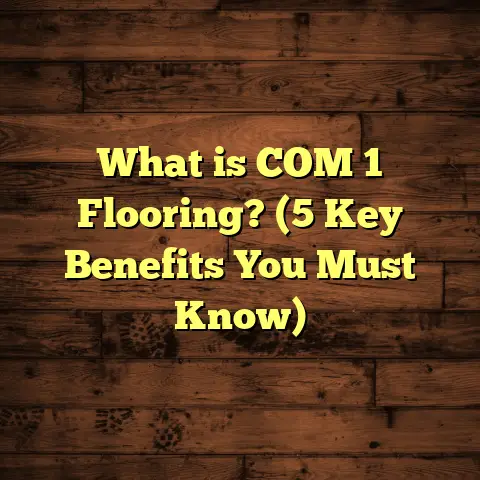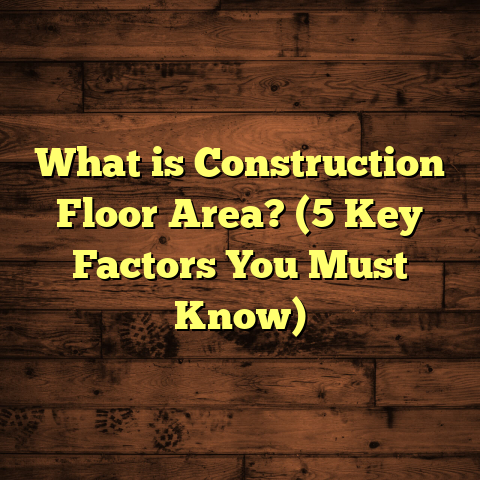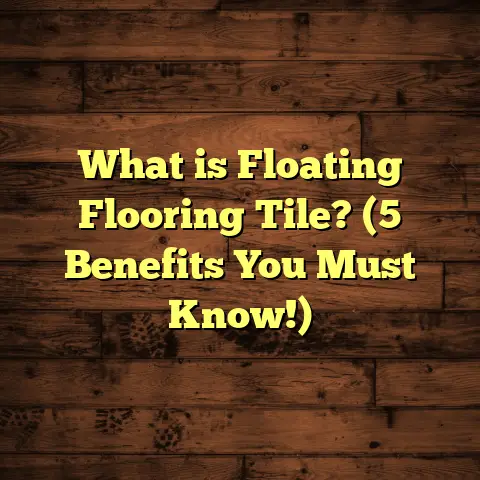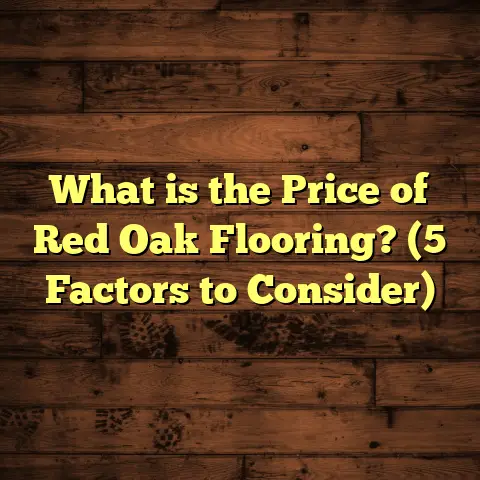What is More Expensive: Hardwood Floors or Tile? (3 Key Comparisons)
What Is More Expensive: Hardwood Floors or Tile? (3 Key Comparisons)
When I first started working in flooring, one question came up so often it practically became my signature phrase: “Which is more expensive—hardwood or tile?” You might think it’s a simple yes or no answer, but the truth is more layered, just like the floors themselves. Choosing between hardwood and tile isn’t just about sticker price. It’s about materials, installation, maintenance, lifespan, and even how each one impacts your home’s vibe and value.
If you’re trying to pick the best option without breaking your budget or regretting your choice later, you’re in the right place. Let me walk you through everything I’ve learned on the job — real costs, real challenges, and the little things people don’t always talk about.
What Are Hardwood Floors and Tile Floors?
Before diving deep into costs, let’s clarify what hardwood and tile actually are. Understanding their nature helps explain why prices vary so much.
Hardwood Floors
Hardwood floors come from solid wood trees—oak, maple, cherry, walnut—each with its own character and durability. You’ll find two main types: solid hardwood, which is a thick plank of wood ready to be sanded and finished onsite, and engineered hardwood, which has a plywood base with a thin veneer of real wood on top. Engineered hardwood resists moisture better and can be installed in basements or over concrete slabs where solid hardwood might warp.
Hardwood floors are prized for their warmth, natural beauty, and timeless appeal. They tend to darken or lighten with age depending on the species and finish, giving each floor a unique personality.
Tile Floors
Tile floors are made from ceramic, porcelain, or natural stone like marble, granite, or slate. Ceramic tiles are made from clay and fired in a kiln—durable but can be porous unless glazed. Porcelain tiles are a denser type of ceramic fired at higher temperatures; they resist water better and are less prone to cracking. Stone tiles bring incredible natural beauty but require sealing to prevent stains.
Tiles come in tons of shapes, sizes, finishes (matte or glossy), and patterns—from classic subway tiles to mosaics to large-format slabs.
1. Initial Material and Installation Costs
Material and installation represent the biggest chunk of your flooring budget. Here’s what I’ve seen across hundreds of projects:
Material Costs Breakdown
- Solid Hardwood: Generally $5 to $10 per sq ft for commonly used species like oak or maple. Exotic woods like Brazilian cherry or mahogany can push $12 to $20 per sq ft.
- Engineered Hardwood: Slightly cheaper at $4 to $7 per sq ft because it uses less solid wood.
- Ceramic Tile: Wide range—$1 to $15 per sq ft—because basic white tiles cost pennies while decorative or large-format tiles cost more.
- Porcelain Tile: Usually $3 to $20 per sq ft; high-end porcelain can rival stone tile prices.
- Natural Stone Tile: The most expensive material-wise—$7 to $20+ per sq ft depending on rarity and finish.
When I helped a client pick flooring for a mid-century modern renovation, they went for an engineered hardwood at around $6 per square foot. It looked stunning but was easier on their budget than solid oak.
Installation Costs Details
Installing hardwood requires skill:
- Flooring must be acclimated to room humidity for days beforehand.
- Solid hardwood typically needs nailing or stapling down over wood subfloor.
- Sanding and applying finish onsite adds labor hours.
- Engineered hardwood can be floated (click-lock) or glued down.
Tile installation is labor-intensive:
- Subfloor must be perfectly level—sometimes requiring costly prep work.
- Tiles are set in thinset mortar.
- Cutting tiles to fit edges and corners takes time.
- Grout application and sealing afterward add steps.
Typical installation costs:
- Hardwood: $4 to $8 per sq ft
- Tile: $7 to $15 per sq ft
One time I worked on an old home where the subfloor was uneven under the kitchen. Installing porcelain tile ended up costing 40% more because we had to add a leveling layer before laying tile! That’s an expense people often forget.
Tip: Always get multiple quotes from experienced installers familiar with both materials so you know what surprises might pop up.
2. Maintenance and Longevity Costs
Flooring isn’t a “set it and forget it” deal. Both hardwood and tile need care to look good decade after decade.
Hardwood Floor Upkeep
Hardwood floors can last lifetimes but need some love:
- Regular sweeping or vacuuming to avoid grit scratching the finish.
- Use wood-safe cleaners; avoid water soaking.
- Pets and kids can cause dents or scratches.
- Refinishing required every 7-10 years depending on wear (costs about $3-$5 per sq ft).
- Refinishing involves sanding off old finish and applying new stain/sealer.
I’ve refinished floors in homes where pets had scratched deeply. It’s satisfying work because the floor almost looks brand new afterward—but not cheap or quick.
Moisture is hardwood’s enemy—spills need wiping up fast or the wood can warp or stain. In humid climates, wood expands and contracts seasonally which can cause gaps or cupping if floors aren’t installed with proper acclimation.
Tile Floor Upkeep
Tile floors are low-maintenance but not maintenance-free:
- Sweep or mop regularly.
- Avoid abrasive cleaners that can dull glaze.
- Grout is porous; it needs sealing every 2-3 years ($0.50-$1 per sq ft).
- Over time grout can stain or crack.
- Replacing broken tiles requires finding a matching tile and careful removal/install.
I once had a client whose dog chewed a corner off a porcelain tile. We replaced that tile for about $60 including labor. Not bad compared to replacing a hardwood plank but still something unexpected to budget for.
Tile is water-resistant—great for bathrooms or kitchens—but cold underfoot unless you add radiant heating underneath (which adds upfront cost).
Longevity Comparison
Both materials have great longevity when maintained:
- Hardwood floors last 30+ years; some historic homes still have original planks from 100+ years ago.
- Tile floors often last 50+ years or longer; they don’t wear out but grout may need repair.
If you’re looking for something that lasts forever with minimal fuss, tile edges out hardwood slightly here.
3. Aesthetic Value and Resale Impact
How does flooring choice affect home value? This is where personal taste meets market trends—and I’ve seen real outcomes from homes I’ve worked on.
Hardwood Floors Add Warmth
Hardwood floors have that classic look that people love for living rooms and bedrooms. They add warmth both visually and physically—especially in cooler climates.
Many buyers associate hardwood with quality construction and timeless style. It’s common for homes with beautiful hardwood floors to sell faster and at higher prices.
According to National Association of Realtors data I reviewed recently:
- Homes with hardwood floors sell for 2% to 5% more on average.
- Hardwood boosts buyer interest significantly.
I remember one client who upgraded their entire main floor with white oak hardwood before listing. Their house sold for $15,000 more than similar homes nearby with carpet or laminate.
Tile Has Its Place
Tile is essential in wet areas like bathrooms, laundry rooms, mudrooms, kitchens—places where water resistance matters most.
Some buyers prefer tile throughout for easy cleaning; others find it cold or less inviting in living spaces unless it’s high-end stone or warm-toned porcelain.
Stone tile especially can feel luxurious but might not appeal to all buyers because of upkeep concerns (sealing) and coldness without radiant heat.
Regional Differences
Where you live matters too! In warmer climates like Florida or California, tile is very popular due to cooling properties. In colder northern states, hardwood tends to be preferred for warmth underfoot.
If you’re planning to sell your home soon after installing flooring, consider local preferences carefully.
Digging Deeper: How I Approach Flooring Cost Questions With Clients
Over my years as a flooring contractor, I’ve developed a system for helping clients figure out what fits their budget without sacrificing style or quality. Here’s how I break it down:
Step 1: Measure Your Space Accurately
You’d be surprised how often people underestimate the square footage they need by 10% or more. Always measure twice—or thrice!—and add about 10% for waste (cut-offs, mistakes).
For example, a 1,000 sq ft room will realistically require about 1,100 sq ft of material when you factor waste.
Using online tools like FloorTally helps me quickly calculate costs including waste factors based on local labor/material rates.
Step 2: Define Your Priorities and Lifestyle
Ask yourself:
- How much traffic will this floor see?
- Do you want warm wood tones or sleek tile?
- Are pets/kids in the house?
- How much time do you want to spend maintaining floors?
- Are you planning on selling soon?
This helps narrow choices dramatically.
Step 3: Set a Budget Range
I recommend clients decide on a budget range early. Flooring projects can balloon if you’re not firm on limits.
For instance:
- Budget-conscious: Basic ceramic tile (~$3/sq ft installed)
- Mid-range: Engineered hardwood (~$7/sq ft installed)
- Premium: Solid hardwood or natural stone tile ($12+/sq ft installed)
Step 4: Get Multiple Quotes & Samples
Never go with the first quote without comparing. Ask installers about warranties, prep work needed, timeline.
Always see samples in your home lighting before deciding—the same wood or tile can look very different depending on light and room size.
Case Study #1: Family Home Renovation (Hardwood vs Tile)
A family I worked with wanted durable flooring throughout their open-plan living/dining/kitchen area (about 1,200 sq ft). They loved the look of hardwood but worried about spills with young kids.
We priced both options:
| Option | Material Cost | Installation Cost | Total Cost |
|---|---|---|---|
| Solid Oak Hardwood | $9/sq ft | $6/sq ft | $18,000 |
| Porcelain Tile | $12/sq ft | $10/sq ft | $26,400 |
They went with hardwood because they preferred warmth underfoot and planned regular refinishing every 10 years. The higher tile cost plus cold feeling tipped the scales for them.
Case Study #2: Kitchen Remodel in Humid Climate (Tile Wins)
In Florida, I worked on a kitchen remodel where moisture was a big concern. The homeowner initially wanted engineered hardwood but after discussing risks of warping and swelling due to humidity and spills, they chose porcelain tile instead.
Costs were:
| Option | Material Cost | Installation Cost | Total Cost |
|---|---|---|---|
| Engineered Hardwood | $7/sq ft | $5/sq ft | $9,600 |
| Porcelain Tile | $10/sq ft | $12/sq ft | $21,600 |
Though tile was pricier upfront, they saved money long term by avoiding damage repairs from moisture issues common with wood in kitchens there.
Bonus Tips for Saving Money Without Sacrificing Quality
- Buy Flooring During Sales: Many suppliers offer discounts seasonally.
- Consider Engineered Hardwood: Cheaper than solid wood but offers similar looks.
- Do Prep Work Yourself: Removing old flooring or leveling subfloors can reduce labor costs.
- Hire Experienced Installers: Poor installation leads to expensive repairs later.
- Plan Maintenance Budget: Factor refinishing/sealing costs upfront so you’re not surprised later.
Final Thoughts From Someone Who’s Walked Hundreds of Homes
I get that flooring decisions feel huge because they impact look, feel, budget—and how much time you spend cleaning or fixing floors later. After seeing dozens of projects from start to finish, here’s my honest take:
- Hardwood floors cost more upfront than basic ceramic tile but offer timeless beauty and warm comfort that many homeowners cherish.
- Tile can be cheaper or more expensive depending on type but usually costs more to install; it wins on durability and low maintenance.
- Long-term costs depend on your lifestyle—pets/kids raise maintenance needs for hardwood; grout upkeep is key for tile longevity.
- Think regionally—tile may be better in humid climates; hardwood shines in drier/cooler areas.
Ultimately, neither choice is objectively “better” or “more expensive” without context—it comes down to your budget constraints, style preferences, maintenance willingness, and how long you plan to stay in your home.
If you want help figuring out exact costs for your space using tools like FloorTally or advice tailored to your project specifics, just ask! Flooring decisions don’t have to be stressful—I’m here to help make it simple.
Would you like me to walk you through cost estimates based on your room size? Or maybe share some photos of past projects that balance budget with style? Just let me know!





